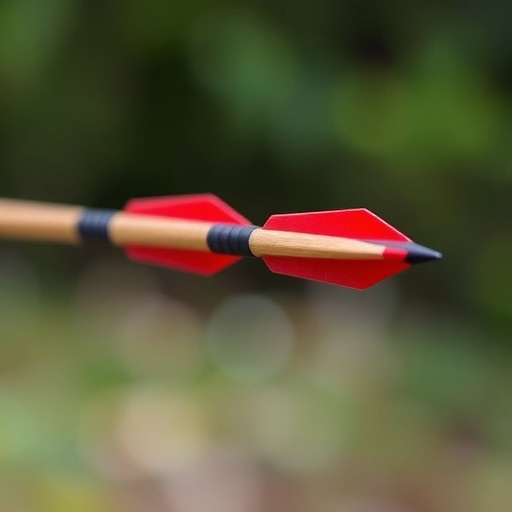In a groundbreaking study published in the esteemed journal Sports Engineering, researchers led by Kuch, Laguillaumie, and Durand delve into the intricacies of archery, unveiling critical insights into the arrow selection process. This research is particularly timely as the sport continues to gain international traction, with archers seeking precise performance optimization. The study’s central proposition revolves around the stiffness variation patterns in arrows, a factor that has been under-explored in the context of competitive archery.
Archery has long been celebrated for its blend of skill, precision, and equipment ergonomics. Yet, despite its rich history and the technical advancements made over the years, the nuances of arrow stiffness have remained relatively untouched in a substantive, quantifiable manner. This new exploration by Kuch and colleagues not only fills a significant knowledge gap but also proposes a new methodology for archers at all levels, particularly those honing their craft for competition or recreational excellence.
The research team utilized an intricate experimental design, incorporating a diverse array of arrows with varied stiffness. This approach enabled them to assess how these variations impact shooting accuracy and overall performance. Through precise data collection and analysis, they showcased how the flexural characteristics of arrows can influence the trajectory and ultimate landing point of the arrow, thereby critically affecting an archer’s success rate.
Additionally, the study examined the biomechanics of archery, emphasizing the relationship between an archer’s technique and the arrows they select. By integrating human biomechanics with the physical properties of the arrows, the researchers highlighted the importance of tailoring equipment to personal (and situational) shooting styles. A standardized approach to arrow stiffness could thus lead to breakthroughs in shooting accuracy, underscoring the scientific rigor behind what many consider an artistic sport.
One particularly innovative aspect of the research was the use of advanced statistical analyses to correlate stiffness with performance metrics. By establishing strong statistical links, the team provided empirical evidence to support the claim that stiffness does indeed matter. Their findings have the potential to reshape how archers approach the selection of arrows, bringing a new level of scientific backing to what was once a primarily subjective decision.
The implications of these findings are profound, particularly for competitive archers who often face intense pressure to perform. Customizing arrow stiffness according to an archer’s unique draw weight and shooting style could become a critical component in pre-competition preparation. The study suggests a systematic approach where archers could assess their performance with various stiffness rates, ensuring that the selected arrow complements their technique, enhances stability, and maximizes their chances of achieving a bullseye.
Moreover, the psychological effects of using the “correct” arrow cannot be underestimated. Arrows that feel right in an archer’s hand can boost confidence, improve focus, and ultimately elevate one’s performance during competitions. This study provides not only the technical evidence to support different stiffness variations but also a psychological framework that could encourage archers to experiment and find their ideal match in arrow selections.
As the popularity of archery burgeons with increased visibility in the Olympics and competitive venues worldwide, studies such as this one become essential knowledge assets for athletes and coaches alike. Understanding the science behind equipment choices allows not only for improved individual performance but also opens avenues for developing new training protocols. Archery clubs, teams, and academies can integrate these findings into their curricula, leading future generations of archers towards more informed practices.
Furthermore, manufacturers of archery equipment might find practical applications for the findings. Companies could innovate new arrow designs that emphasize customizable stiffness options based on user data, enhancing the product’s appeal and efficacy. This synergy between research and industry can propel the sport further into a realm where technology and tradition coexist, potentially revolutionizing the gear available to athletes.
In conclusion, this pivotal research by Kuch et al. sets the stage for a new narrative in archery, emphasizing the often-overlooked importance of arrow stiffness. By systematically exploring how variations impact performance, they’ve provided a foundational step toward optimizing the sport. As archers, coaches, and manufacturers adapt to these insights, the future of archery may indeed be brighter, more precise, and scientifically-informed than ever before.
The study serves as a reminder that even in sports perceived as age-old, there exists a realm of untapped knowledge waiting to be explored. As researchers continue to investigate the myriad factors influencing athletic performance, it is likely that future studies will build upon this initial groundwork, delving deeper into biomechanics, material science, and ergonomic design.
With an engaged community of archers eager to learn and grow, the ripple effects of this research could influence not just competitive outcomes but inspire recreational participants to explore the sport with renewed vigor. As the arrows fly toward targets, so too does the quest for precision and perfection in archery continue, with academia and practice evolving hand in hand.
Subject of Research: Arrow stiffness and its impact on archery performance
Article Title: Improving the arrow selection process in archery: the stiffness variation pattern matters.
Article References:
Kuch, A., Laguillaumie, P., Durand, F. et al. Improving the arrow selection process in archery: the stiffness variation pattern matters. Sports Eng 28, 8 (2025). https://doi.org/10.1007/s12283-025-00487-7
Image Credits: AI Generated
DOI:
Keywords: Archery, arrow stiffness, performance optimization, biomechanics, sports engineering




